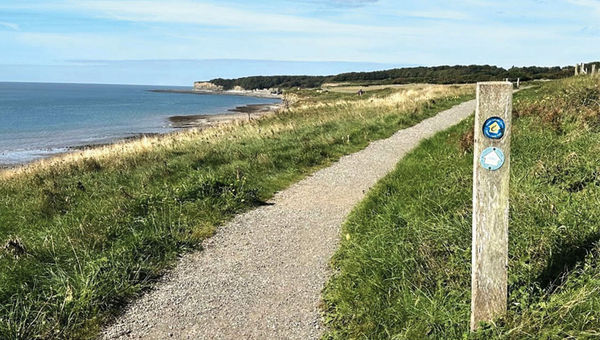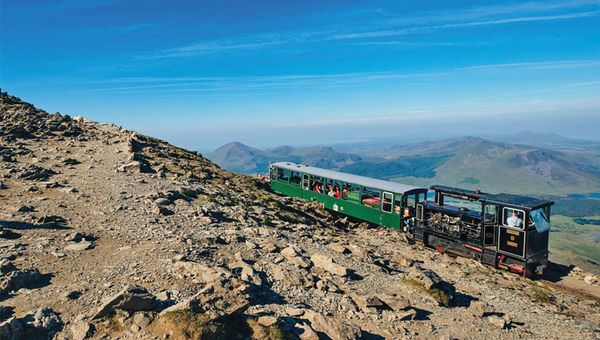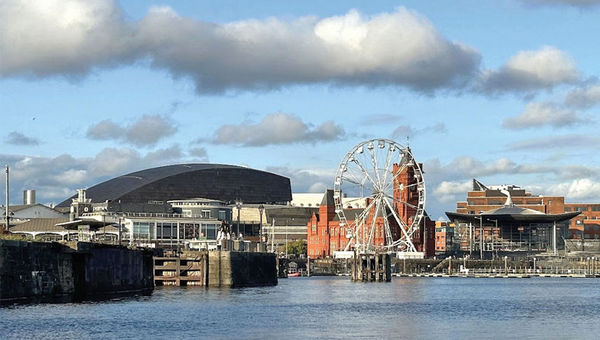Lofty towers, secret dungeons and legends of Camelot beckon visitors to the ancient castles of Wales.
This small country has 400-plus fortresses that are still standing -- more per square mile than any European country. For castle enthusiasts, Wales is the place to climb dank spiral staircases to stroll atop castle walls.
But Wales, which is part of the U.K., is not a prisoner of its past. And while it shares the island of Great Britain with England and Scotland, it's no replica of its better-known neighbors.
Wales has its own story to tell in its own lyrical language. Welsh, along with English, appears on everything from road signs to pub menus.
Even the food is a little different. Griddle-baked Welsh cakes look like scones but are flakier. Savory cheese sauce distinguishes Welsh rarebit from a grilled cheese sandwich. Welsh ale is darker and laced with honey.
"Wales has a lot to talk about, from our coastal trail and rugged scenery to our culture and heritage," Robert Lewis Jones, an executive with the Welsh tourism organization Visit Wales, told me over lunch at a cafe in Cardiff in September.
I had to agree after spending 10 days exploring the country. In search of what sets Wales apart, I mixed castle spotting with coastal path walks, national park hikes and a long weekend in the lively capital city of Cardiff.
After flying into London and renting a car, I started in North Wales. Trains provide regular service from London to most cities in Wales, while buses link small towns. Tours are also available.
The weather can be as wet in Wales as elsewhere on the island, but I only raised an umbrella occasionally. Some highlights:

The Wales Coast Path spans the country's entire 870-mile coastline. Photo Credit: Barbara Redding
Wales Coast Path
Wales, which is about the size of New Jersey with 3.2 million people, boasts crescent beaches and rocky cliffs lapped by the Irish Sea. Trekkers can tackle all or sections of its western shoreline on the 870-mile Wales Coast Path, which spans the country's entire coastline.
The trail passes through national parks and along estuaries, lighthouses, fishing villages and busy urban areas. I walked the trail whenever I was near the coast to enjoy the country's diverse landscape, from green valleys dotted with grazing sheep to rocky hillsides awash in purple heather and yellow gorse.
Castles of Wales
Conwy, a town still encircled by medieval walls, makes an excellent starting point to explore the castle-rich north coast. English King Edward I built the fortress atop a cliff overlooking the Conwy River in the 1200s.
Part of an "Iron Ring" of four castles now designated Unesco World Heritage sites, Conwy is still visually intimidating with eight haunting towers and nearly a mile of intact walls. If you hold tight to the rope railings, you can climb spiral staircases for glorious sea and mountain views.
From Conwy, it's a short coastal drive to my favorite castle, Caernarfon, where King Charles III was crowned Prince of Wales in 1969. Long before Charles began his ascent to the throne, King Edward I's son was born in the castle and named the first Prince of Wales, cementing English control.
Caernarfon's historical exhibits include a Victorian-style carousel illustrating the life of Queen Eleanor, wife of King Edward I and a savvy businesswoman. A castle museum tells the history of the Royal Welsh Fusiliers, Wales' oldest military regiment.

The Snowdonia Mountain Railway takes riders up Snowdon, the country's highest peak. Photo Credit: Courtesy of Crown Copyright
Snowdonia National Park
The northernmost of three national parks, Snowdonia National Park is a vast sanctuary for nature lovers and hikers, with craggy mountains, highland lakes, lush valleys and cascading waterfalls.
Open-air rail cars ascend along the spine of Snowdon, the country's highest peak at 3,560 feet. The three-hour ride on the Snowdon Mountain Railway includes panoramic views from the top. Hikers get a closer look at old slate mines and crumbling stone cottages, but the trek can take up to seven hours.
Anglesey Island
Bucolic farmland rolls to a dramatic end on Anglesey Island in northwest Wales. The South Stack Lighthouse perches on a rocky inlet connected by a suspension bridge. By descending 400 stone steps, you can explore the 1809 lighthouse.
You can also observe its elusive profile peeking out of the fog, as I did, from above on the Wales Coast Path.
To reach South Wales, I traveled through the country's rolling green midsection, stopping to watch kayakers on the wild River Dee in quaint Llangollen. The town is home to Plas Newydd, a Gothic-style mansion trimmed in black and white that was owned by two women whose scandalous love affair in the 1800s helped inspire the BBC series "Gentleman Jack."
From Llangollen, the roads dip and curve around the lush peaks and valleys of Brecon Beacons National Park before abruptly descending into bustling Cardiff.

Cardiff Bay's modern harbor once shipped coal around the world. Now the area is home to trendy pubs and restaurants. Photo Credit: Barbara Redding
Cardiff
The multicultural capital of Cardiff melds the country's coal-mining past with its future as one of Europe's more progressive and environmentally conscious cities.
Cardiff's coal docks drew workers from around the world during the Industrial Revolution. The 3rd Marquess of Bute amassed a fortune from black gold and then spent it re-creating his medieval fantasies in a must-see mansion within Cardiff Castle.
What's actually medieval is the castle's massive stone keep, erected by invading Normans in the 11th century. A castle wall dates to the Roman occupation in the First Century. Bomb shelters and tunnels built into castle walls recall life during World War II air raids.
From the castle, I strolled through several Victorian shopping arcades, crowded with coffeeshops, restaurants and Welsh retail stores. Nearby, Principality Stadium attracts boisterous fans during the national rugby games.
Cardiff Bay is about an hour's walk from downtown, but water taxis whisk passengers in less time via scenic cruises along the River Taff.
The bay's once gray tidal water is now a blue freshwater lake crisscrossed by sailboats, thanks to the Cardiff Bay Barrage, a dam completed in 2001. Dubbed Mermaid Quay, the harbor draws throngs of young people to trendy pubs and seafood restaurants.
Wales' future shines on the waterfront. An ultramodern glass building houses the Senedd, the Welsh Parliament. The nation's professional arts groups perform in another modern structure, the Millennium Centre, whose copper dome beams with a poem written in Welsh and English.